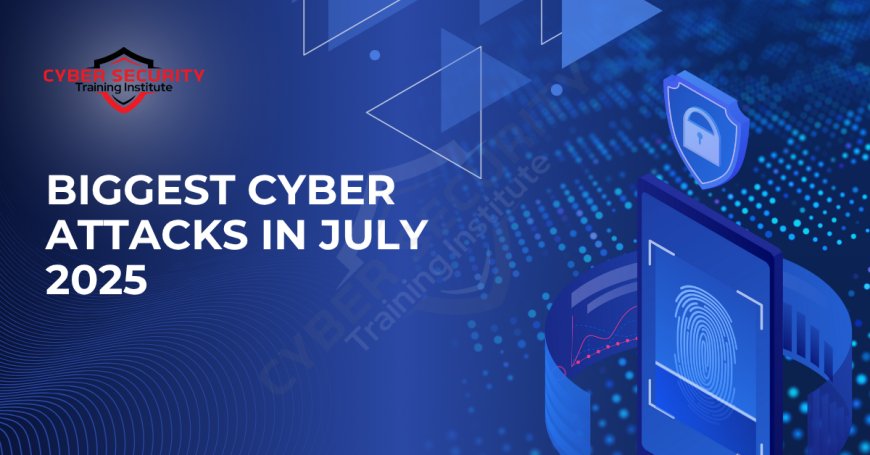What Are the Biggest Cyber Attacks Making Headlines in July 2025?
Stay ahead of the cybersecurity curve with a detailed breakdown of the biggest cyber attacks in July 2025. From AI ransomware to deepfake fraud, explore how threat actors are breaching global systems and what you can do to stay protected.

Introduction
As cybersecurity threats evolve, July 2025 has witnessed some of the most significant and alarming cyber attacks to date. From state-sponsored breaches to AI-powered phishing and large-scale ransomware operations, the landscape is rapidly shifting. This article explores the biggest cyber attacks that grabbed global headlines this month, the tactics used, affected sectors, and what organizations can learn from them.
1. AI-Driven Ransomware Hits European Healthcare Systems
One of the most devastating attacks this July involved a highly coordinated ransomware operation targeting multiple hospitals across Germany, France, and the Netherlands. The ransomware, dubbed “MedCrypt-AI”, was designed using AI algorithms to bypass traditional endpoint protection by dynamically changing file signatures and behavior patterns.
Impact
- Over 70 hospitals disrupted
- Patient data encrypted and held hostage
- Ransom demands ranged from €1M to €5M per institution
2. Massive Credential Theft via Fake Generative AI Tools
Attackers launched a global phishing campaign disguised as access to "premium AI productivity tools". These campaigns tricked users into downloading malware-ridden software that silently harvested credentials.
Key Takeaways
- Victims spanned over 15 countries
- Tech, media, and finance sectors most affected
- Google Chrome extensions and LinkedIn were the primary delivery methods
3. U.S. Government Contractor Breach via Third-Party Access
On July 7, a U.S. defense contractor reported a breach traced back to a compromised third-party accounting vendor. The breach exposed sensitive government documents, including classified logistics schedules.
Attack Vector
- Initial access through compromised Microsoft 365 credentials
- Lateral movement enabled by unpatched ZeroLogon exploit
- Data exfiltrated to encrypted servers in Russia
4. Cryptocurrency Exchange Breach Results in $140M Theft
One of Asia’s top crypto exchanges suffered a high-profile attack resulting in the theft of nearly $140 million worth of digital assets. The breach was attributed to a supply chain vulnerability in a widely used multi-signature wallet module.
Consequences
- Exchange halted withdrawals for 48 hours
- Investigation revealed threat actor was North Korea’s Lazarus Group
- Over 250,000 users affected globally
5. Voice Cloning Fraud Targets Indian Telecom Executives
In India, a new wave of AI voice cloning attacks is on the rise. Threat actors impersonated C-level executives at major telecom firms using deepfake audio to authorize large fund transfers and disclose confidential information.
Key Highlights
- 4 firms lost a combined ₹18 crore
- Audio deepfakes were indistinguishable from real calls
- Incident prompted new government advisories on deepfake detection
6. Zero-Day Exploit in Router Firmware Exposes Millions
A zero-day vulnerability discovered in a major router vendor’s firmware allowed attackers to remotely access home and corporate networks without authentication. The exploit was reportedly sold on darknet forums prior to public disclosure.
Mitigation Measures
- Vendors issued emergency firmware updates
- Over 4 million devices globally estimated to be vulnerable
- ISPs began auto-patching customer devices
7. Targeted Phishing Attacks in Education Sector
Universities in the UK and Canada reported a series of advanced phishing attacks that used AI-generated content to craft convincing emails posing as university officials, tricking staff into transferring research data.
Outcomes
- Over 12 institutions affected
- Ongoing investigations with cybersecurity agencies
- Call for AI-aware phishing training across education sectors
8. Cloud Misconfiguration Leads to Data Leak at HealthTech Firm
A misconfigured AWS S3 bucket at a U.S. health tech startup led to a breach exposing over 500,000 patient records. Security researchers found the data through routine scans and reported it responsibly.
What Went Wrong
- No authentication or encryption enabled on bucket
- PII, medical records, and insurance info exposed
- Company now facing regulatory penalties under HIPAA
Quick Overview of July 2025 Major Cyber Attacks
| Attack Name | Target | Attack Type | Estimated Impact |
|---|---|---|---|
| MedCrypt-AI | European hospitals | AI-powered ransomware | €50M+ in losses |
| AI Tool Phishing | Global users | Credential theft | 5M+ credentials stolen |
| Contractor Supply Chain Breach | US Gov’t Contractor | Third-party access | Classified leaks |
| Crypto Exchange Theft | Asia-based exchange | Supply chain exploit | $140M stolen |
| Voice Clone Fraud | Indian telecoms | Deepfake voice | ₹18 Cr financial loss |
Conclusion
Cyber attacks in July 2025 have set a new precedent in terms of sophistication and scale. From AI-powered phishing to deepfake fraud and supply chain vulnerabilities, the need for proactive cybersecurity strategies has never been more urgent. These incidents highlight the importance of regular patching, zero-trust frameworks, employee awareness training, and investing in intelligent threat detection systems to stay ahead of attackers.
FAQ
What is the most significant cyber attack in July 2025?
The AI-powered ransomware attack on European hospitals was the most significant, affecting over 70 institutions.
What type of malware was used in the healthcare attack?
An adaptive ransomware named MedCrypt-AI that used AI to evade detection.
How were fake AI tools used in cyber attacks?
They were used as bait to trick users into downloading malware that harvested login credentials.
Which group was behind the cryptocurrency theft?
The Lazarus Group, a North Korean state-sponsored threat actor.
What is a supply chain attack?
It involves compromising a trusted third-party service to gain access to the main target.
How do voice cloning attacks work?
AI models replicate voices using audio samples, which are then used to authorize transactions or steal data.
What is ZeroLogon?
It's a known Windows vulnerability that allows attackers to gain domain admin access in networks.
What can organizations do to stop AI phishing?
Deploy AI-powered email filtering, train employees, and use zero-trust architectures.
Why are cloud misconfigurations dangerous?
They can expose sensitive data if access controls and encryption are not properly configured.
Are deepfakes a growing threat in cybersecurity?
Yes, they are increasingly being used in fraud, phishing, and impersonation attacks.
How can firms detect AI-generated phishing emails?
With behavioral anomaly detection and email security platforms that use machine learning.
What sectors are most affected by cyber attacks in July 2025?
Healthcare, finance, government, education, and crypto industries were heavily targeted.
Can home users be affected by these attacks?
Yes, especially through phishing, infected extensions, and router vulnerabilities.
What’s the importance of patching firmware?
It closes zero-day vulnerabilities that attackers exploit for network access.
How did attackers use browser extensions?
Malicious extensions disguised as AI tools were used to collect user credentials.
How can universities protect themselves?
By enforcing MFA, AI-aware phishing simulations, and tight data access policies.
What are common signs of a phishing email?
Urgency, mismatched domains, unexpected links, and slightly altered sender names.
What tools can detect voice cloning?
Deepfake detection tools and behavioral analytics on call systems.
Is AI helpful in defending against cyber threats?
Absolutely. AI helps identify abnormal behavior, detect malware, and automate response.
Should businesses invest in cybersecurity training?
Yes, especially to combat social engineering and AI-powered attack vectors.
What's Your Reaction?
 Like
0
Like
0
 Dislike
0
Dislike
0
 Love
0
Love
0
 Funny
0
Funny
0
 Angry
0
Angry
0
 Sad
0
Sad
0
 Wow
0
Wow
0







![How to Install RHEL 10 on VMware/VirtualBox [Tutorial]](https://www.cybersecurityinstitute.in/blog/uploads/images/202509/image_430x256_68b56dc967a4a.jpg)







